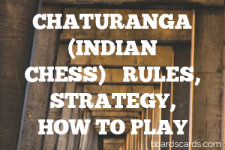Dominoes: A Player’s 101 Guide to Rules, Instructions and Winning Strategy
Introduction
Dominoes (sometimes Domino or Dominos) is a classic game that’s been around for centuries. It’s a tile-based game that’s easy to learn but can get pretty strategic and competitive. Plus, most people already vaguely know how to play dominoes, which I find makes it always a fun option to the more board-game-resistant types. The game has a set of rectangular tiles, each with two square ends marked with a number of spots, or ‘pips’. The main goal is to get rid of all your tiles by matching the pips on one end of your tile with the pips on an open end of a tile on the table.

There’s a bit of history to this game too. It’s believed to have originated in China in the 12th century, and it made its way to Europe in the 18th century, hence why I categorize it as an ‘ancient’ game. Since then, it’s become a global pastime with lots of different variations and is especially popular among older communities.
Some similar games which use hefty, clacky-like tile pieces include Azul and Rummikub, two games I’ve also written guides on if you fancy diversifying your game nights!
Quick Tip for Dominoes
Always pay attention to the tiles played by your opponents. It can give you clues about what tiles they might still hold, which can be crucial for your strategy.
Rules for playing Dominoes
When you’re playing Dominoes, the rules can vary a bit depending on the version you’re playing, but I’ll go over the basics that are common in most games.
First, you shuffle the tiles face down and each player draws a set number, usually seven. The player with the highest double goes first, placing that tile in the center. From there, players take turns adding tiles to the open ends, with the matching number of pips. If you can’t play a tile, you draw from the remaining ‘boneyard’ until you can.
Some variations have different rules about drawing tiles, so make sure to agree on the rules before starting. The round ends when a player has played all their tiles or when the game is blocked and no more moves are possible. Scoring can be based on the pips remaining in the losing players’ hands or other methods depending on the game variation.
Equipment and Setup for Dominoes
To play Dominoes, you need a set of domino tiles. A standard set, also known as a double-six set, has 28 tiles, each with a unique combination of pips from 0 (blank) to 6. There are larger sets too, like double-nine or double-twelve, for games with more players or different variations.
For setup, shuffle the tiles face down and draw your hand. The rest of the tiles form the boneyard, which is used for drawing when you can’t make a play.
How to Play Dominoes and Game Mechanics
The key game mechanics in Dominoes involve matching the number of pips on the ends of the tiles and strategic play to block your opponents or clear your hand quickly. Here’s a breakdown of the gameplay phases:
- Setup: Shuffle the tiles and draw your starting hand.
- Gameplay: Take turns adding tiles to the layout with matching numbers of pips.
- End of the Game: The game ends when a player clears their hand or no more moves can be made.
Adding tiles to the center, also known as the playfield or the line of play, is governed by a simple yet crucial set of rules that ensure the game progresses in an orderly fashion. Players must place their tiles adjacent to the dominoes that are already on the table, matching one of the exposed ends with an identical number of pips (the dots on a domino).
For instance, if there is a tile with a 5 on one end exposed in the playfield, a player can add a tile with a 5 on one of its ends, aligning the matching numbers side by side. The orientation of the tile doesn’t matter as long as the numbers match. The game continues with each player adding tiles in turn, and the first player to play all their tiles, or the player with the least pips after the game is blocked, wins.
It’s important to note that some variations of dominoes might have additional or alternative rules, but the fundamental principle of matching the numbers remains consistent across most versions of the game.
How to Win at Dominoes
Winning at Dominoes involves a mix of strategy, luck, and paying attention to your opponents’ moves. Beginners should focus on clearing their hand while keeping an eye on what’s being played. Intermediate players can start to play more strategically, blocking opponents and setting up the board to their advantage. Advanced players will have a deep understanding of the game’s probabilities and can often predict opponents’ hands and control the flow of the game.
Best Strategies for playing Dominoes game
To really excel at Dominoes, you need to develop a strategy. This involves knowing when to play your high-value tiles, when to hold back, and how to force your opponents into difficult positions. You should also be aware of the tiles that have been played and what’s likely left in your opponents’ hands. Sneaky tactics can include bluffing about the tiles you hold or strategically playing doubles to change the direction of play.
One of the best strategies, I find, is to control the board by maintaining a variety of dominoes in your hand, ensuring you can play on as many ends as possible. Keeping a mental note of which tiles have been played helps to predict opponents’ hands and block their moves by playing tiles that force them to draw from the boneyard, or pass their turn.
Another effective tactic is to play your heavy tiles early, as the game may end abruptly leaving you with a high score that could be added to your opponent’s total. Additionally, it’s crucial to be adaptable; if you notice an opponent is about to run out of tiles, shift your strategy to block their progress, either by changing the playable ends or by making it difficult for them to play their preferred tiles.
Mastering the art of dominoes lies in the delicate balance between offensive play to progress your own game and defensive measures to disrupt your opponents’.
Scenarios
Good scenarios in Dominoes might include having a variety of tiles that can fit in many places, or holding onto a key tile that you know your opponent needs. Bad scenarios could be having only high-pip tiles that make your hand vulnerable to high scoring if someone else goes out. To turn these scenarios to your advantage, try to change the board to suit your hand or play defensively to minimize points against you.
Additional Subtopics
There are many variations of Dominoes, like ‘Draw’ and ‘Block’ games. Some games use a larger set of tiles, like double-nine or double-twelve sets, for more complex play. There are also different ways to score, like ‘Five-Up’ where points are scored during gameplay. Dominoes can be played in pairs or teams, which changes the dynamic and strategy of the game.
Variations of Dominoes
There are quite a few Dominoes variations – as you’d expect from a near 1000-year-old-game – that I recommend trying if you get bored of the original Dominoes setup:
- Block Dominoes:
- Players draw a specific number of tiles (usually 7) and take turns placing tiles on the board.
- A player who cannot play passes the turn. The first player to play all their tiles wins the round.
- Scoring involves counting the total pips on remaining opponents’ tiles.
- Draw Dominoes:
- Players draw a specific number of tiles (usually 7) and take turns playing a tile or drawing from the boneyard.
- The goal is to be the first to play all tiles or have the fewest points when the game ends.
- Mexican Train Dominoes:
- Uses a special set of double-12 Dominoes.
- Players start their own “train” and try to play as many tiles on it as possible.
- If a player can’t play on their train, they start a “Mexican Train” that other players can play on.
- The round ends when a player plays all their tiles, and points are scored based on opponents’ remaining tiles.
- All Fives Dominoes:
- Points are scored based on multiples of 5.
- Any multiple of 5 (e.g., a tile with 5 pips or a 3-2 tile) scores points for the player.
- The goal is to be the first to reach a set point total.
- Matador Dominoes:
- Played with a double-9 set.
- Players draw tiles, and the first player to play all their tiles wins.
- If a player cannot play, they must draw from the boneyard.
- The game ends when a player reaches a predetermined score or when a set number of rounds is played.
- Bergen Dominoes:
- Players score points for making the open ends of the layout add up to a multiple of 5.
- The game is usually played to a set number of points.
- Spinner Dominoes:
- Uses a set with a designated “spinner” tile (e.g., a double-9).
- The spinner is placed in the center, and players can play tiles off any side of the spinner.
- The game is played to a set number of points or rounds.
- Chickenfoot Dominoes:
- Players aim to create a “chickenfoot” pattern by playing a double tile followed by three tiles.
- Points are scored based on the total pips on opponents’ remaining tiles when a player goes out.
- Solitaire Dominoes:
- A solo game where the player tries to match tiles and clear them from the board.
- Success is achieved by clearing all tiles following specific rules.
These variations demonstrate the diversity of Dominoes, and many regional and personal variations exist, adding to the richness of the game.
Frequently Asked Questions about playing Dominoes
- Q: How many tiles do you start with in Dominoes?
A: Typically, each player starts with seven tiles.
- Q: Can you put a tile down on either side of the layout?
A: Yes, as long as the number of pips matches the open end you’re connecting to.
- Q: What happens if you can’t make a play?
A: You draw from the boneyard until you can play a tile.
- Q: How do you score in Dominoes?
A: Scoring can vary, but it’s often based on the total number of pips in your opponents’ hands when you go out.
- Q: What’s a ‘boneyard’ in Dominoes?
A: The boneyard is the pile of remaining tiles that players draw from when they can’t make a play.
External Links
For more information on Dominoes and official rulebooks, check out these resources:
World Domino Federation – US-based Players’ Association
International Council of Domino – Africa-based Players’ Association
Online Domino Simulator – Free, No Registration

Eve Brownlee was a gamer before gaming communities on the internet were a thing. Eve grew up playing traditional, standard deck card games like Rummy and Bezique, taking an interest in the classics Backgammon and Chess. Parlor card games like Bridge continue to keep Eve active in the community. After a long career, primarily in horticulture for USDA in Maryland, Eve now travels and writes on The Pineapple (pineapples.info) and contributes to Quora/Pinterest topics. Contact Eve via email.



